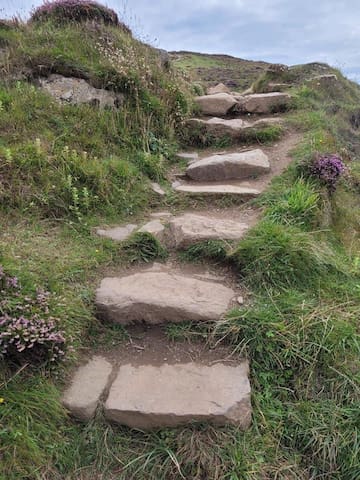Sightseeing
The pride and joy of Pembrokeshire and in fact Wales, is the beautiful St.David’s Cathedral. Hidden nestled in a small valley in the centre of St.David’s, you would hardly know it was there!
Nowhere in Britain is there a more ancient cathedral settlement, for it reaches back fourteen centuries.
An extract from Lonely Plant -
Hidden in a hollow and behind high walls, St David's Cathedral is intentionally unassuming. The valley site was chosen in the vain hope that the church would be overlooked by Saxon raiders, but it was ransacked at least seven times. Yet once you pass through the gatehouse separating it from the town and its stone walls come into view, it's as imposing as any of its contemporaries.
Built on the site of a 6th-century chapel, the building dates mainly from the 12th to the 14th centuries. Extensive works were carried out in the 19th century by Sir George Gilbert Scott (architect of London's Albert Memorial and St Pancras) to stabilise the building. The distinctive west front, with its four pointed towers of purple stone, dates from this period.
The atmosphere inside is one of great antiquity. As you enter the nave, the oldest surviving part of the cathedral, the first things you'll notice are the sloping floor and the outward lean of the massive, purplish-grey pillars linked by semicircular Norman Romanesque arches, a result of subsidence. Above is a richly carved 16th-century oak ceiling, adorned with pendants.
At the far end of the nave is a delicately carved 14th-century Gothic pulpitum (screen), which bears a statue of St David dressed as a medieval bishop, and contains the tomb of Bishop Henry de Gower (died 1347), for whom the Bishop's Palace was built.
124 íbúar mæla með
St. Davids dómkirkja
The PebblesThe pride and joy of Pembrokeshire and in fact Wales, is the beautiful St.David’s Cathedral. Hidden nestled in a small valley in the centre of St.David’s, you would hardly know it was there!
Nowhere in Britain is there a more ancient cathedral settlement, for it reaches back fourteen centuries.
An extract from Lonely Plant -
Hidden in a hollow and behind high walls, St David's Cathedral is intentionally unassuming. The valley site was chosen in the vain hope that the church would be overlooked by Saxon raiders, but it was ransacked at least seven times. Yet once you pass through the gatehouse separating it from the town and its stone walls come into view, it's as imposing as any of its contemporaries.
Built on the site of a 6th-century chapel, the building dates mainly from the 12th to the 14th centuries. Extensive works were carried out in the 19th century by Sir George Gilbert Scott (architect of London's Albert Memorial and St Pancras) to stabilise the building. The distinctive west front, with its four pointed towers of purple stone, dates from this period.
The atmosphere inside is one of great antiquity. As you enter the nave, the oldest surviving part of the cathedral, the first things you'll notice are the sloping floor and the outward lean of the massive, purplish-grey pillars linked by semicircular Norman Romanesque arches, a result of subsidence. Above is a richly carved 16th-century oak ceiling, adorned with pendants.
At the far end of the nave is a delicately carved 14th-century Gothic pulpitum (screen), which bears a statue of St David dressed as a medieval bishop, and contains the tomb of Bishop Henry de Gower (died 1347), for whom the Bishop's Palace was built.
You simply cannot visit St.David’s without paying a trip to the Blue Lagoon.
An old quarry that was opened up to allow the sea to fill.
A short walk around the coast path from the pebble beach.
Perfect for cliff jumping, but beware there are no lifeguards. Most cliff jumpers are part of organised activities.
78 íbúar mæla með
Blue Lagoon
You simply cannot visit St.David’s without paying a trip to the Blue Lagoon.
An old quarry that was opened up to allow the sea to fill.
A short walk around the coast path from the pebble beach.
Perfect for cliff jumping, but beware there are no lifeguards. Most cliff jumpers are part of organised activities.
Walking
We have the most beautiful coastline in the U.K, and the coast path can be joined from any local beach.
Pembrokeshire Coast Path
Pembrokeshire Coast PathFood scene
Beautiful pub grub with a homely atmosphere in this ancient harbour pup.
Just a few miles from the site on the coast road.
Highly recommend for families.
53 íbúar mæla með
Sloop Inn
Beautiful pub grub with a homely atmosphere in this ancient harbour pup.
Just a few miles from the site on the coast road.
Highly recommend for families.
Beaches
A favourite beach for families and only approx 5 miles from the site.
Clean beach, soft sand, clean water.
Cafe, Toilets, Surf Hire, Cafe, Icecream, Lifeguards.
Paid parking.
66 íbúar mæla með
Whitesands Bay
Pembrokeshire Coast PathA favourite beach for families and only approx 5 miles from the site.
Clean beach, soft sand, clean water.
Cafe, Toilets, Surf Hire, Cafe, Icecream, Lifeguards.
Paid parking.
A small beach in St.David’s. Not ideal for someone with limited mobility as there is a steep concrete path and steps to access.
However a beautiful small beach worth a visit.
6 íbúar mæla með
Caerfai Beach
Ffordd CaerfaiA small beach in St.David’s. Not ideal for someone with limited mobility as there is a steep concrete path and steps to access.
However a beautiful small beach worth a visit.


